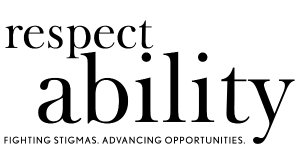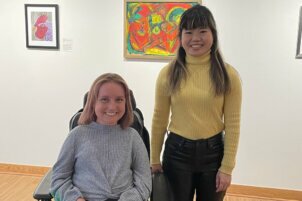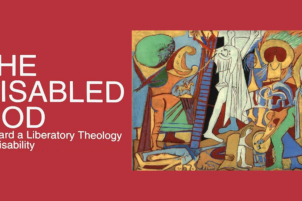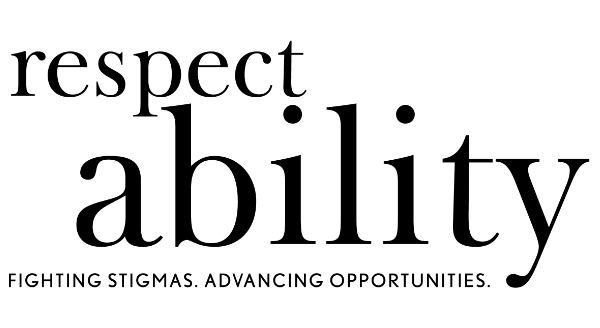Written by Faith Inclusion and Belonging Fellows Hannah Roussel and Sara Sharma
What Was The 504 Sit-In All About?
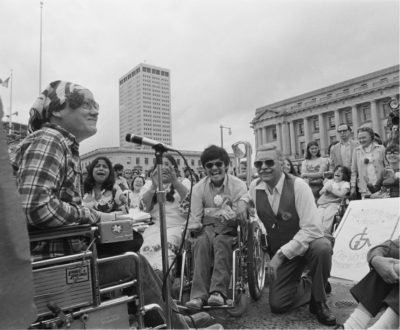
Disability Rights Activist Kitty Cone
On April 5, 1977, in San Francisco, disability activists occupied a federal building for 26 days, until Section 504 of the Rehabilitation Act – granting new rights to disabled people – was signed into law. This protest came with many challenges, and faith and spirituality played a significant part in sustaining the activists. The 504 sit-in was an inevitable event given that it had taken four years for President Carter and his Secretary of Health, Education, and Welfare, Joseph Califano, to sign and enact the Rehabilitation Act. Due to the intentional negligence of Joseph Califano, Judy Heumann and the other activists (more than 100 people) felt that it was time that they initiated a change to speed up the process.
They took direct action by occupying the federal building (San Francisco’s Health, Education, and Welfare offices) for 26 days. Their aim was to demonstrate the gravity of being an unprotected person in the United States and the immediate urgency of signing the protections of Section 504 into law. The activists went through harsh conditions, including a hunger strike, sleeping on staircases, carrying heavy backpacks, and limited supplies of food, medication, and water. Many did not have their usual supports of medical attendees, family, and nurses. They were on their own. Despite the activists being peaceful, they endured violence from police officers and the other opposing protesters who were against their cause. It was not until April 28, 1977, that Section 504 was finally signed into law, making all their hard work worth it.
Connection Between Spirituality and Activism
In her memoir, Judy Heumann writes how the symbolism of Passover (a Jewish holiday that coincided with the sit-in) inspired her to keep going:
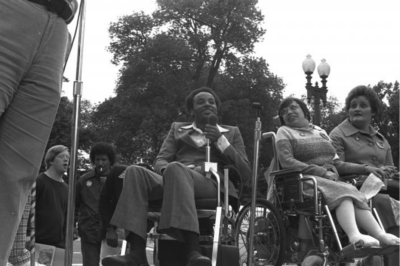
Activists Bradley Lomax and Judy Heumann at the 504 Sit-In
“It was Saturday, April 9, our fourth day in the building. It was also the seventh day of Passover […]. Now, the symbolism hit me. The deliverance of the Israelites from slavery. Freedom. Lying there on the floor, in the dark of the early morning, I smiled to myself. My body was sore from sleeping on the floor and I hadn’t eaten for days, but I felt good.”
It was deeply sustaining for religious participants of sit-in to maintain their spiritual practices. Jewish disability activists held Shabbat dinner in a freight elevator and celebrated Passover in the building. Christian activists at the sit-in were uplifted by weekly Sunday services, an Easter service, and an Easter egg hunt.
Spirituality not specific to any particular faith was equally important to ensuring the sit-in’s success. Dennis Billups, an African American blind man participating in the sit-in, took it upon himself to ensure these needs were being met, and was affectionately called the “the spiritual leader” of the 504 Sit-In.
Billups told the Guardian that “I was just making sure that we had our minds together to keep going forward and not look back. And to sing as often as we could, and to make sure that we checked on each and every other person around us, so that we could have that sense of unity. I went around the building, sometimes all night, doing cheering, doing counselling, doing listening, doing debating, that kind of stuff. I had to keep people up. I think that’s what I saw as my greatest gift: that I brought in the universal aspect with the meditation and spiritualism that kept a lot of stuff together.”
Fellow protestors felt buoyed by Billups’ efforts of leading people in songs, chants, and meditations. When describing these moments, Billups told Sojourners Magazine that they “linked hand and hand, heart to heart, mind to mind, and spirit to spirit together.”
To learn more details about the 504 sit-in, check out the resources that are included below! Stay tuned for our next post on the importance of faith-based inclusion and belonging in the disability community. In the meantime, you can start increasing accessibility and awareness in your faith community now by checking out our Faith Inclusion and Belonging website here at RespectAbility.
Resources
- Patient No More – A virtual exhibit about the 504 Sit-In by San Francisco State University
- Being Heumann: An Unrepentant Memoir of a Disability Rights Activist – Judy Heumann’s autobiography
- JDAIM Reflections on Faith and Disability with Judy Heumann – A RespectAbility webinar from February 2023 featuring a conversation with Judy Heumann.
- “Dennis Billups: he helped lead a long, fiery sit-in – and changed disabled lives” – Interview with Billups in The Guardian
- “What’s Next for Disability Rights?” – Sojourners Magazine article on faith and spirituality in the 504 Sit-In
- Disability Visibility – A book edited by Alice Wong
- Crip Camp – An Academy Award-nominated documentary
- Demystifying Disability – A book by Emily Ladau
- The Power of 504 – An award-winning documentary about the 504 Sit-In
- The 45th Anniversary of the 504 Sit-In – A conversation between Judy Heumann, Dennis Billups, and Emily Smith Beitiks
